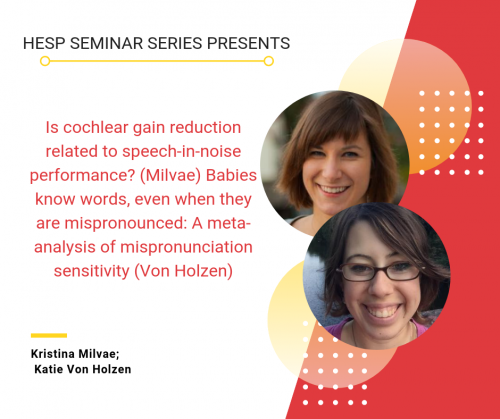Speakers: Kristina Milvae & Katie Von Holzen
Titles: Is cochlear gain reduction related to speech-in-noise performance? (Milvae) Babies know words, even when they are mispronounced: A meta-analysis of mispronunciation sensitivity (Von Holzen)
Abstracts:
Listening to speech in noisy environments is difficult for listeners with normal hearing, but a task that is often accomplished successfully. The mechanisms that underlie this ability are not well understood. A known physiological mechanism that may contribute to this ability is the medial olivocochlear reflex (MOCR). The MOCR is a bilateral reflex between the brainstem and cochlea that reduces cochlear gain in response to sound. Correlational studies have explored the relationship between cochlear gain reduction and speech-in-noise processing with mixed results. Some studies found that individuals with higher measures of cochlear gain reduction had better performance on speech-in-noise tasks, others found the opposite relationship, and yet others have found no relationship. The contrasting findings likely stem from differences in the research paradigms. This experiment aimed to overcome previous limitations by controlling the MOC pathways activated across measures and by measuring speech-in-noise understanding at multiple signal-to-noise ratios (SNRs). It was hypothesized that the relationship would be dependent on the SNR. Psychoacoustic (forward masking) and physiologic (otoacoustic emissions) measures of cochlear gain reduction were used to examine the relationship between cochlear gain reduction and speech-in-noise performance at multiple SNRs. A significant relationship between the psychoacoustic measure and speech-in-noise performance was found at a negative SNR; individuals with larger gain reduction estimates at 2 kHz had poorer performance on the speech-in-noise task. This result is consistent with the idea that turning down the gain should only improve performance when the overall response to the noise is decreased more than the response to the speech. (Milvae) Before infants become mature speakers of their native language, they must acquire a robust word-recognition system which allows them to strike the balance between allowing some variation (mood, voice, accent) and recognizing variability that potentially changes meaning (e.g. cat vs hat). Together with my co-author Christina Bergman, we conducted a meta-analysis with the goal of quantifying how the latter, termed mispronunciation sensitivity, changes over infants’ first three years, testing competing predictions of mainstream language acquisition theories. Our results show that infants were sensitive to mispronunciations, but nonetheless accepted them as labels for target objects. Interestingly, and in contrast to predictions of mainstream theories, mispronunciation sensitivity was not modulated by infant age, suggesting that a sufficiently flexible understanding of native language phonology is in place at a young age. (Von Holzen)



